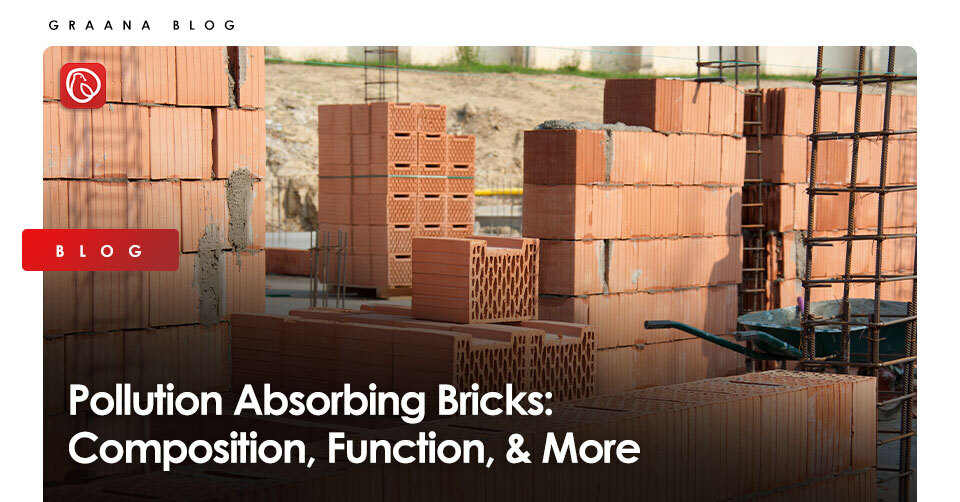
Due to the rise in population, the world is facing critical issues such as climate change, scarcity of food and water, and pollution. To overcome these issues, researchers have come up with various solutions.
Sustainability is one of the factors that hold the highest significance in the construction sector. Thanks to the advancement in technology, we have innovated various sustainable materials and one of these inventions is pollution absorbing bricks.
In this blog Graana.com, Pakistan’s smartest property portal explains everything regarding pollution absorbing bricks, including their composition and function.
With regard to climate change, one of the growing concerns is air pollution. Its severe effects on human health can not be denied. The excess carbon in the air that emits from artificial resources entraps heat on the surface of the earth, which has caused global temperatures to rise.
To cater to these prevalent issues, designers and architects have taken measures to reduce the carbon footprint in the environment, so that its dangerous effects on the atmosphere can be minimized.
Pollution absorbing bricks were invented to tackle the issue of air pollution. They are an amazing alternative to traditional bricks. They are also known as “breath bricks.” Mr Ar. Carmen Trudell – assistant professor at Cal Poly San Luis Obispo’s School of Architecture is the founder of these bricks.
Pollution absorbing bricks work on the principle of air filtration. They filter the air from the outside and provide the filtered air to the inside of the structure. These bricks separate dust particles and other pollutants from the air, leaving it clean, and safe for breathing.
The bricks are a work of genius inspired by the concept of “cyclone filtration” that one sees in vacuum cleaners.
Pollution blocking bricks come in the form of poriferous concrete blocks. Their shape and design is devised particularly in a faceted manner to let the airflow inside them with ease. To reinforce the structure, shafts are supplied.
A coupler rod made of reused plastic is located between two bricks, also, a hopper is attached at the bottom part which collects dirt particles.
Breath bricks act as a passive filtration setup fixed in the walls of the structure. It possesses a cavity wall which is a two-layered structure built on the exterior with pollution-absorbing bricks which block pollutants and an internal wall that insulates the inner atmosphere of the structure.
Inside the breath brick, a cyclone filtration filter is attached. The filter lets the air from the surroundings pass through the brick, like a cyclone, where it separates the pollutants and dust and lets the clean air enter the internal structure.
After that, a brick coupler – an essential part of the system, directs the filtered air. It is made up of recycled plastic and is more of an outlet for filtered air. Furthermore, it directs the filtered particles to the hopper.
As all of the dust particles get collected in the hopper, the user needs to empty and clean it regularly. However, they don’t need to clean it on a daily basis due to its immense size.
The brick coupler positions the bricks by putting out the structural reinforcement through one of its shafts. Once the filtration is done, the air passes through the chamber and into the opening.
Besides, if there is a functioning outlet or window in the structure, then the air directly enters the interiors through it. In case there is no functioning opening, the air passes through the HVAC system.
A test was carried out to determine the capacity of pollution-absorbing bricks. The results show that the bricks filter up to 30% of dust particles of about 2.5 microns diameter or smaller. This is equal to the effects of smoke or haze. It blocks 100% of rough particles that have a diameter of more than or equal to 10 microns.
This system is more eco-friendly as it does not utilize any mechanical components. Moreover, pollution-absorbing bricks are an innovative approach to sustainable construction materials.
Besides being more environmentally friendly, it is more economic compared to the air filtration technology used on a large scale.
Moreover, no special skilled laborers are required to install the system, making it even more cost-effective. Developing countries can use this technology as an economic way to tackle the problem of air pollution while making sure that people get to breathe in better quality air while indoors.
In addition to advantages, there are some disadvantages of pollution absorbing bricks as well, which are as follows.
This pollution-absorbing brick wall takes twice the space as regular walls. It certainly can result in a reduction of space inside the structure.
These bricks have less capacity to bear the load of the total structure of the building, hence you can only build two-storey structures with these walls.
For a more eco-friendly tomorrow, pollution-absorbing bricks are the perfect solution. They are suitable for areas where the air quality is poor, particularly in developing countries.
For more information, visit Graana.com.
ISLAMABAD, Pakistan – April 23, 2025 – Chaaye Khana, Pakistan's popular cafe renowned for its…
ISLAMABAD: Prime Minister Shehbaz Sharif laid the foundation stone for the Murree Road underpass on…
DUBAI: Pakistani real estate developers and representatives showcased a range of commercial and residential investment…
ISLAMABAD: Capital Development Authority (CDA) is currently undertaking a major Rs652 million project to upgrade…
Karachi – Mayor Barrister Murtaza Wahab has announced the launch of a citywide anti-encroachment operation…
ISLAMABAD: CDA Chairman Muhammad Ali Randhawa has directed the immediate restoration of 23 non-functional water…